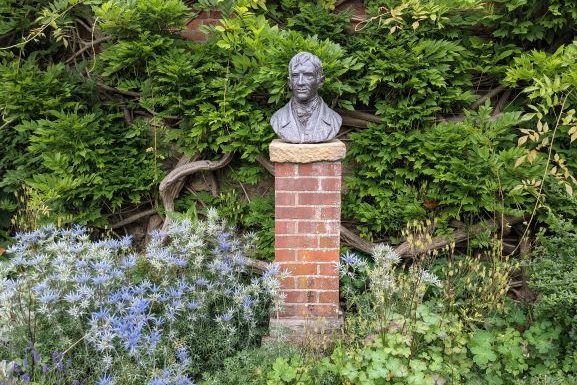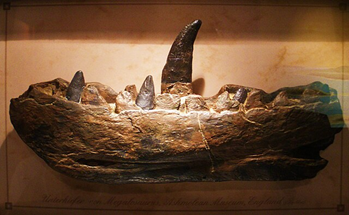John Henry Newman in Littlemore
From its Community Newsletter, I understand that Littlemore is a pleasant place to live and has a low crime rate. There was the unfortunate case of the disappearing pet green parrot but I suspect its perpetual squawking may have had something to do with it. In any event I was there not as prospective house-buyer but to visit places associated with John Henry Newman, founder member of the High Church Oxford Movement, who is closely associated with this south eastern suburb of the city.
Ordained in Christ Church cathedral in 1823, he became vicar of St Mary the Virgin in 1828 whose duties, by some quirk of fate, included responsibility for the pastoral care of Littlemore, Although it had no church of its own, Newman visited his Littlemore flock diligently and introduced catechism classes for the children. He worked on more mundane issues too: “I have effected a great reform (for the time) in the girls’ dirty faces and hands – lectured with unblushing effrontery on the necessity of their keeping their work clean and set them to knit stockings with all their might. Also, I am going to give them some clean, white pinafores.”
Newman campaigned ceaselessly for Littlemore to have its own church. In 1836 a Chapel of Ease was consecrated. The flowers, cloths and ornaments were objects of veneration to some but seen as dangerously ritualistic by others: Newman wrote, “We have some sweet roses, wall flowers and sweet briar and the Chapel smells as if to remind one of the Holy Sepulchre,” but an anniversary procession to celebrate the consecration was greeted with a cry of “Popery.” In 1847, Littlemore had become a separate parish and the Chapel of Ease became the parish church of St Mary and St Nicholas. A modest building in the Gothic revival style, it was closed when we visited because of Covid but we were able to enjoy the foxgloves by the main door and the ancient yews in the graveyard.
What we were able to see was the College, a row of modest cottages bought by Newman, which became home throughout his time in Littlemore. The entrance is through the row of one-story stone buildings leading into a pleasant flower garden and lawn with a bust of Newman directly opposite. The buildings belong to the Birmingham Oratory and are administered by the Society of the Work, an international community of nuns dedicated to spreading the saint’s work.
One of their members showed us around his rooms: the library as well as books, had the tall wooden desk where he stood to write, its surface, scratched by the sharpening of quill pens. Its ink-well was of the kind I had used at school to hold my soot-and-water ink. Letters in elegant old-fashioned writing were on display and more personal items such as his rosary. The walls were lined with photographs of founder members of the Oxford Movement such as Pusey and John Keble. His bedroom had a red-tiled floor, a plain narrow bed, a black wooden cupboard and a small reading desk overlooking the garden. Adjacent was a small chapel for which Newman had unusually allowed himself the luxury of red brocade wall hangings to disguise, we were told, the rather ugly brickwork.
It may seem odd to 21st century readers to learn that in his time Newman’s preaching had been one of the great attractions of the city:
Nothing at first sight could be more opposite to the great Athenian orator – through many of them he never moved anything but his head…. His hands were not seen… The sermon began in a calm musical voice, the key slightly rising as it went on; there were times when in the midst of the most thrilling passage, he would pause … before uttering with gathered force and solemnity. The gaslight of the pulpit lowered that the preacher might not be dazzled … those standing in the half-darkness thrilled as, after the pause, came, “They say unto him. We are able.” Anne Mozley’s Letters and Correspondence II.
But the most moving of all his sermons must have been the one given on 22nd September 1843. By then Newman thought that it was likely to be his proper place was within the Roman Catholic church. At his farewell service, people audibly sobbed. His departure caused much distress in the Anglican church. He was received into the Roman Catholic church by Blessed Dominic Barberi and on 9th October 1845 and made his first Catholic Communion at a Mass in the chapel at Littlemore. He left Oxford on 23rd February 1846 for the Oratory at Birmingham, having spent his last evening in the house of the Observer at the Radcliff Observatory, a personal friend.
100 years after his death, his Congregation of the Oratory was established in the church of St Aloysius in Woodstock Road. Littlemore and this church show that Newman has at last returned to where he belongs – here in Oxford.
Written by volunteer Jane Allingham. Information taken from a pamphlet put out by the Friends of John Henry Newman.
Want to write your own Oxford-inspired post? Sign up as a volunteer blogger.



